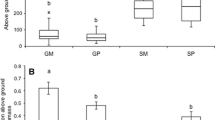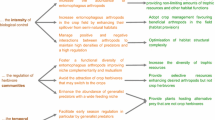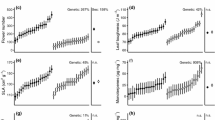Abstract
Biodiversity is quantified via richness (e.g., the number of species), evenness (the relative abundance distribution of those species), or proportional diversity (a combination of richness and evenness, such as the Shannon index, H′). While empirical studies show no consistent relationship between these aspects of biodiversity within communities, the mechanisms leading to inconsistent relationships have received little attention. Here, using common evening primrose (Oenothera biennis) and its associated arthropod community, we show that relationships between arthropod richness, evenness, and proportional diversity are altered by plant genotypic richness. Arthropod richness increased with O. biennis genotypic richness due to an abundance-driven accumulation of species in response to greater plant biomass. Arthropod evenness and proportional diversity decreased with plant genotypic richness due to a nonadditive increase in abundance of a dominant arthropod, the generalist florivore/omnivore Plagiognathas politus (Miridae). The greater quantity of flowers and buds produced in polycultures—which resulted from positive complementarity among O. biennis genotypes—increased the abundance of this dominant insect. Using choice bioassays, we show that floral quality did not change in plant genotypic mixtures. These results elucidate mechanisms for how plant genotypic richness can modify relationships between arthropod richness, evenness, and proportional diversity. More broadly, our results suggest that trophic interactions may be a previously underappreciated factor controlling relationships between these different aspects of biodiversity.




Similar content being viewed by others
References
Alatalo RV (1981) Problems in the measurement of evenness in ecology. Oikos 37:199–204
Balvanera P, Pfisterer AB, Buchmann N, He JS, Nakashizuka T, Raffaelli D, Schmid B (2006) Quantifying the evidence for biodiversity effects on ecosystem functioning and services. Ecol Lett 9:1146–1156
Bell G (2000) The distribution of abundance in neutral communities. Am Nat 155:606–617
Bock CE, Jones ZF, Bock JH (2007) Relationships between species richness, evenness, and abundance in a southwestern savanna. Ecology 88:1322–1327
Cardinale BJ, Srivastava DS, Duffy JE, Wright JP, Downing AL, Sankaran M, Jouseau C (2006) Effects of biodiversity on the functioning of trophic groups and ecosystems. Nature 443:989–992
Cardinale BJ, Wright JP, Cadotte MW, Carroll IT, Hector A, Srivastava DS, Loreau M, Weis JJ (2007) Impacts of plant diversity on biomass production increase through time because of species complementarity. Proc Nat Acad Sci USA 104:18123–18128
Cleland RE (1972) Oenothera: cytogenetics and evolution. Academic Press, New York
Cook LM, Graham CS (1996) Evenness and species number in some moth populations. Biol J Linn Soc 58:75–84
Cook-Patton SC, McArt SH, Parachnowitsch AL, Thaler JS, Agrawal AA (2011) A direct comparison of the consequences of plant genotypic and species diversity on communities and ecosystem function. Ecology 92:915–923
Crowder DW, Northfield TD, Strand MR, Snyder WE (2010) Organic agriculture promotes evenness and natural pest control. Nature 466:109–112
Crutsinger GM, Collins MD, Fordyce JA, Gompert Z, Nice CC, Sanders NJ (2006) Plant genotypic diversity predicts community structure and governs an ecosystem process. Science 313:966–968
De Benedictis PA (1973) On the correlations between certain diversity indices. Am Nat 107:295–302
Dickson TL, Wilsey BJ (2009) Biodiversity and tallgrass prairie decomposition: the relative importance of species identity, evenness, richness, and micro-topography. Plant Ecol 201:639–649
Duffy JE, Cardinale BJ, France KE, McIntyre PB, Thebault E, Loreau M (2007) The functional role of biodiversity in ecosystems: incorporating trophic complexity. Ecol Lett 10:522–538
Elton CS (1958) The ecology of invasions by animals and plants. Methuen & Co. Ltd., London
Genung MA, Lessard J-P, Brown CB, Bunn WA, Cregger MA, Reynolds WN, Felker-Quinn E, Stevenson ML, Hartley AS, Crutsinger GM, Schweitzer JA, Bailey JK (2010) Non-additive effects of genotypic diversity increase floral abundance and abundance of floral visitors. Plos One 5:e8711
Gotelli NJ, Colwell RK (2001) Quantifying biodiversity: procedures and pitfalls in the measurement and comparison of species richness. Ecol Lett 4:379–391
Haddad NM, Crutsinger GM, Gross K, Haarstad J, Knops JMH, Tilman D (2009) Plant species loss decreases arthropod diversity and shifts trophic structure. Ecol Lett 12:1029–1039
Haddad NM, Crutsinger GM, Gross K, Haarstad J, Tilman D (2010) Plant diversity and the stability of food webs. Ecol Lett 14:42–46
Hairston NG, Allan JD, Colwell RK, Futuyma DJ, Howell J, Lubin MD, Mathias J, Vandermeer JH (1968) The relationship between species diversity and stability: an experimental approach with protozoa and bacteria. Ecology 49:1091
Hillebrand H, Danuta MB, Cadotte MW (2008) Consequences of dominance: a review of evenness effects on local and regional ecosystem processes. Ecology 89:1510–1520
Hooper DU, Chapin FS III, Ewel JJ, Hector A, Inchausti P, Lavorel S, Lawton JH, Lodge DM, Loreau M, Naeem S, Schmid B, Setälä H, Symstad AJ, Vandermeer J, Wardle DA (2005) Effects of biodiversity on ecosystem functioning: a consensus of current knowledge. Ecol Monogr 75:3–35
Hughes AR, Inouye BD, Johnson MTJ, Underwood N, Vellend M (2008) Ecological consequences of genetic diversity. Ecol Lett 11:609–623
Hunt-Joshi TR, Root RB, Blossey B (2005) Disruption of weed biological control by an opportunistic mirid predator. Ecol Appl 15:861–870
Hurlbert SH (1971) The nonconcept of species diversity: a critique and alternative parameters. Ecology 52:577–586
Johnson MTJ (2010) The contribution of evening primrose (Oenothera biennis) to a modern synthesis of evolutionary ecology. Popul Ecol 53:9–12
Johnson MTJ, Lajeunesse MJ, Agrawal AA (2006) Additive and interactive effects of plant genotypic diversity on arthropod communities and plant fitness. Ecol Lett 9:24–34
Larson EL, Bogdanowicz SM, Agrawal AA, Johnson MTJ, Harrison RG (2008) Isolation and characterization of polymorphic microsatellite loci in common evening primrose (Oenothera biennis). Mol Ecol Resour 8:434–436
Loreau M, Hector A (2001) Partitioning selection and complementarity in biodiversity experiments. Nature 412:72–76
Ma M (2005) Species richness vs evenness: independent relationship and different responses to edaphic factors. Oikos 111:192–198
Magurran AE (1988) Ecological diversity and its measurement. Princeton University Press, Princeton
Margalef DR (1958) Information theory in ecology. Gen Syst 3:36–71
May RM (1975) Patterns of species abundance and diversity. In: Cody ML, Diamond JL (eds) Ecology and evolution of communities. Harvard University Press, Cambridge, pp 81–120
Murdoch WW, Peterson CH, Evans FC (1972) Diversity and pattern in plants and insects. Ecology 53:819–827
Parker JD, Duffy JE, Orth RJ (2001) Plant species diversity and composition: experimental effects on marine epifaunal assemblages. Marine Ecol Prog Ser 224:55–67
Parker JD, Salminen J-P, Agrawal AA (2010) Herbivory enhances positive effects of plant genotypic diversity. Ecol Lett 13:553–563
Root RB (1973) Organization of a plant–arthropod association in simple and diverse habitats: fauna of collards (Brassica oleracea). Ecol Monogr 43:95–120
Shannon CE (1948) A mathematical theory of communication. Bell Syst Tech J 27:379–423
Siemann E, Tilman D, Haarstad J, Ritchie M (1998) Experimental tests of the dependence of arthropod diversity on plant diversity. Am Nat 152:738–750
Smith N, Wilson JB (1996) A consumer’s guide to evenness indices. Oikos 76:70–82
Srivastava DS, Lawton JH (1998) Why more productive sites have more species: an experimental test of theory using tree-hole communities. Am Nat 152:510–529
Stirling G, Wilsey B (2001) Empirical relationships between species richness, evenness and proportional diversity. Am Nat 158:286–299
Sugihara G (1980) Minimal community structure: an explanation of species abundance patterns. Am Nat 133:458–463
Tilman D, Wedin D, Knops JMH (1996) Productivity and sustainability influenced by biodiversity in grassland ecosystems. Nature 379:718–720
Tilman D, Reich PB, Knops JMH (2006) Biodiversity and ecosystem stability in a decade-long grassland experiment. Nature 441:629–632
Wheeler AG (2001) Biology of the plant bugs (Hemiptera: Miridae): pests, predators, opportunists. Comstock Pub Associates, Ithaca
Whittaker RH (1965) Dominance and diversity in land plant communities—numerical relations of species express importance of competition in community function and evolution. Science 147:250–253
Weiher E, Keddy PA (1999) Relative abundance and evenness patterns along diversity and biomass gradients. Oikos 87:355–361
Willig MR, Kaufman DM, Stevens RD (2003) Latitudinal gradients of biodiversity: pattern, process, scale, and synthesis. Annu Rev Ecol Evol Syst 34:273–309
Wilsey BJ, Stirling G (2007) Species richness and evenness respond in a different manner to propagule density in developing prairie microcosm communities. Plant Ecol 2:259–273
Wilsey BJ, Chalcraft DR, Bowles CM, Willig MR (2005) Relationships among indices suggest that richness is an incomplete surrogate for grassland biodiversity. Ecology 86:1178–1184
Wimp GM, Young WP, Woolbright SA, Martinsen GD, Keim P, Whitham TG (2004) Conserving plant genetic diversity for dependent animal communities. Ecol Lett 7:776–780
Wittebolle L, Marzorati M, Clement L, Balloi A, Daffonchio D, Heylen K, De Vos P, Verstraete W, Boon N (2009) Initial community evenness favours functionality under selective stress. Nature 458:623–626
Acknowledgments
We thank Monica Kersch-Becker, Gui Becker, Alexis Erwin, Sergio Rasmann, Mike Stastny, Stuart Campbell, and Ordom Huot for assistance with field work. Katja Poveda, Anurag Agrawal, Andre Kessler, and Brian Wilsey provided constructive feedback that greatly improved this manuscript. This work was funded by a Small Grant in Biogeochemistry and Environmental Biocomplexity (NSF IGERT) to SHM and SCC, and a National Research Initiative of the USDA Cooperative State Research, Education and Extension Service, grant number # 2006-35302-17431, to JST.
Author information
Authors and Affiliations
Corresponding author
Additional information
Communicated by Roland Brandl.
Rights and permissions
About this article
Cite this article
McArt, S.H., Cook-Patton, S.C. & Thaler, J.S. Relationships between arthropod richness, evenness, and diversity are altered by complementarity among plant genotypes. Oecologia 168, 1013–1021 (2012). https://doi.org/10.1007/s00442-011-2150-6
Received:
Accepted:
Published:
Issue Date:
DOI: https://doi.org/10.1007/s00442-011-2150-6




